The 2020 Boat of the Year fleet was diverse and intriguing, but with five very cool new models ranging from 31 to 35 feet, no single class was as large or competitive as the Performance Cruisers. In this size range, even for boats whose purpose tilts more toward the racecourse side of the racer-cruiser equation, it’s not enough to design a boat stripped and laid out for speed alone. No, nowadays, basic creature comforts and reasonable accommodations are not only desirable, they’re mandatory, and nearly every boat in this category will not only be a blast to spin around the buoys, but they’ll all also provide an intrepid crew with everything necessary—decent berths, a serviceable galley, a private head—to get away for a week or two of adventurous cruising (the awesome sailing is a given). So, without further ado, here were the nominees for the Best Performance Cruiser for 2020. If you love the pure and simple act of sailing, each of these pocket rockets will provide one sweet ride.
Beneteau Oceanis 30.1
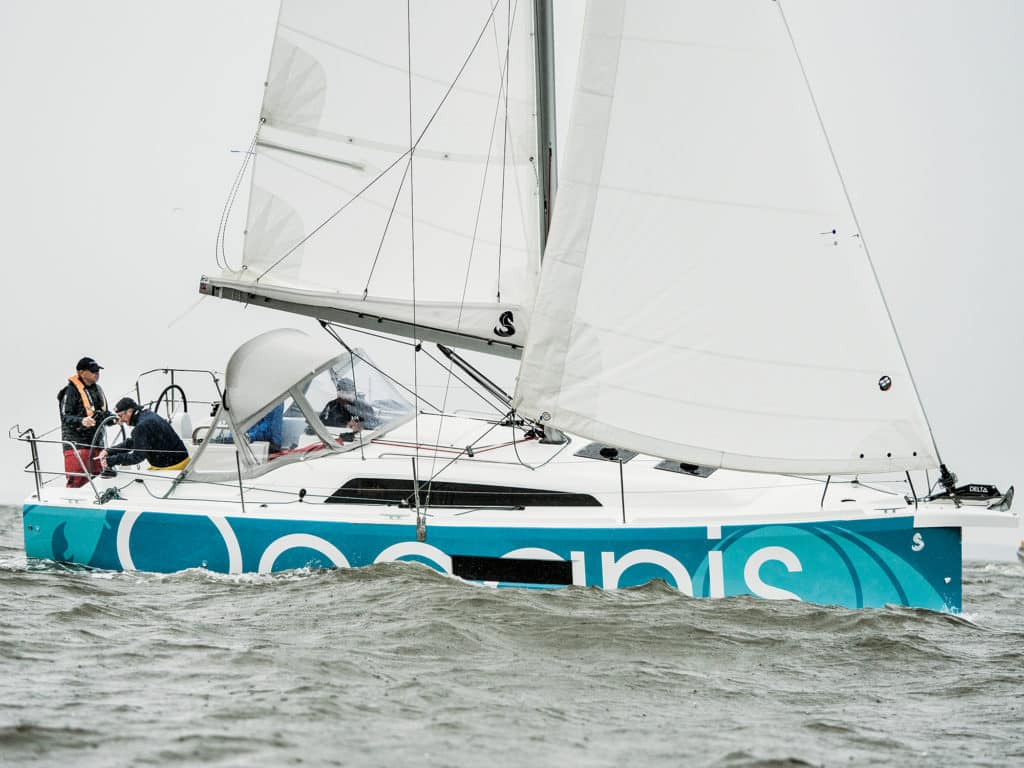
Of the five boats in this collection, the 31-foot-3-inch Beneteau Oceanis 30.1 was the compact yacht best-equipped and spec’d out as a dedicated cruising boat, and not coincidentally, it was also awarded the title of Best Performance Cruiser for 2020. But don’t let her cozy interior accommodations fool you; this is also one peppy little vessel.
One of the major appeals to the judging panel was the 30.1’s versatility. There are four different keel options, or a centerboard. The deck-stepped mast can be equipped with a tabernacle for easy lowering and trailering to a new locale, or for transiting canals. At $160,000, it was also the least-expensive offering in the category. The plusses just kept adding up.
The rig is a single-spreader fractional number with a square-top main, which maximizes power aloft in the sail plan. Our test boat had an overlapping genoa (with adjustable sheet leads) and an optional bowsprit; the standard version has a self-tacking 100 percent headsail. Twin wheels make handling simple, but for old-school dudes (like me), you can also get a tiller. That’s right, a tiller! The transom is complete with a little fold-down boarding step, along with a boarding ladder. At the opposite end, a Facnor headsail furler is stationed beside the Lewmar windlass. The overall attention to detail is terrific.
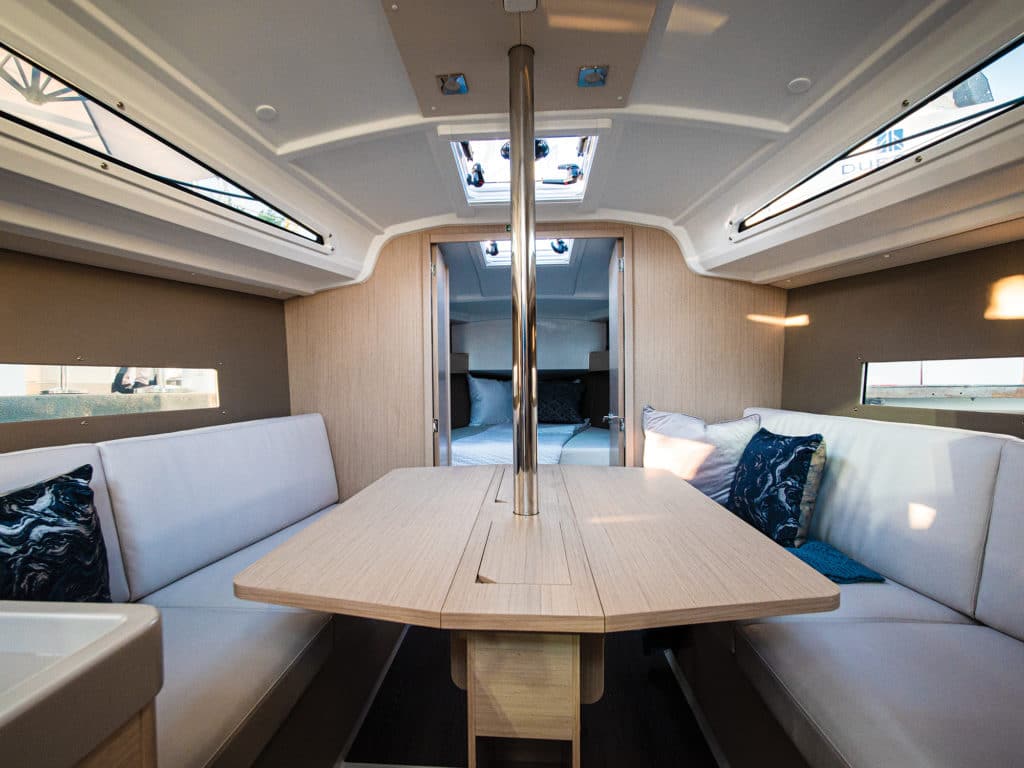
The Beneteau representative who presented the yacht to our judges said that the goal down below was “to fit a bigger boat in a smaller hull, to install a 35-foot interior in a 30-foot boat.” It was certainly an ambitious plan, and one that was largely successful. The V-berth forward is certainly impressive, and that aforementioned deck-stepped spar really opened up the space below, particularly the central saloon and dining area. At the foot of the companionway, the complete galley is to port and the enclosed head to starboard, which is also the locale of a functional little navigation desk. A good-size aft double cabin is also to starboard. For a small family, or a pair of couples, this is a perfectly fine arrangement.
Thanks to the coachroof windows and overhead hatches, there’s plenty of natural light below deck, which is augmented by efficient LED lighting throughout. The bold hull graphics are certainly attention-getters, and the well-executed dodger a perfect place to get out of the weather. Our sail test was conducted in a decent Chesapeake Bay blow, touching 20 knots, and the boat was nimble and responsive. All in all, it’s an impressive package—not to mention, a winning one. beneteau.com; 410-890-0270
Grand Soleil 34
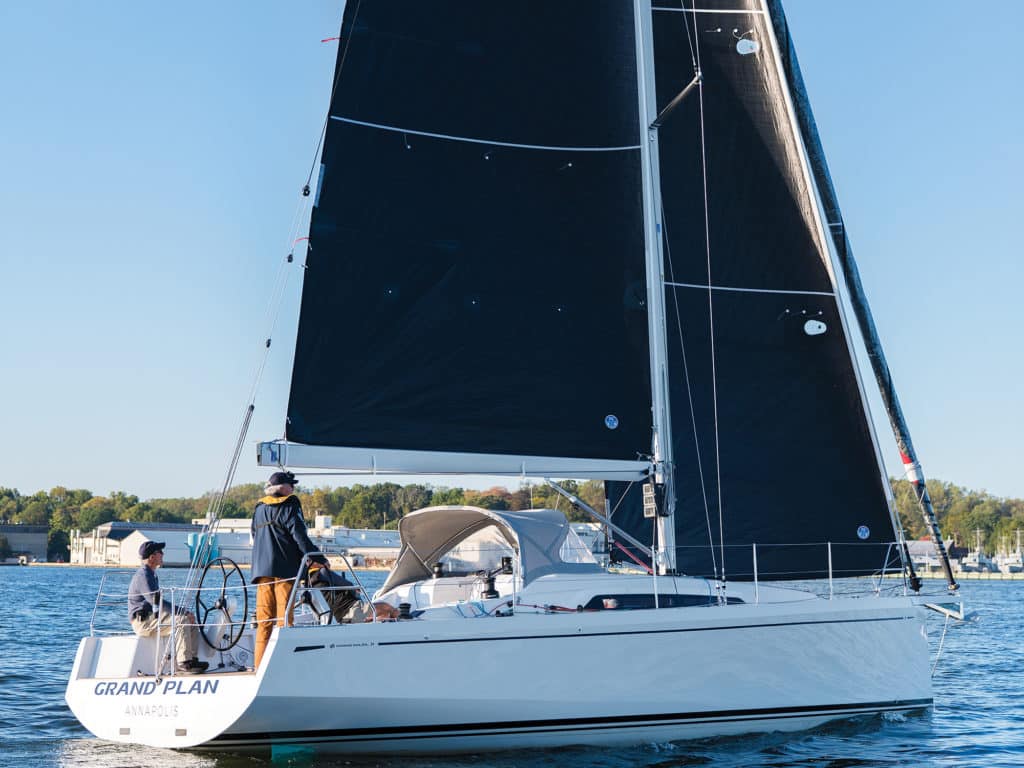
Way back in the 1970s, when the well-known Italian boatyard Grand Soleil was just getting started, its first model was a Finot-designed 34-footer. With over 300 units sold, it was an instant success, and launched the company on an upward trajectory that spanned the intervening decades, mostly with an ongoing series of much larger, more complex racer/cruisers. For 2020, the builder decided to return to its roots with a completely revamped Grand Soleil 34, and it’s a terrific boat.
These days, there are a couple of major rating rules under which racing yachts compete, and a growing movement of doublehanded classes in many major regattas. And, of course, conditions vary wildly depending on where one sails. Grand Soleil has taken all this into account by offering numerous keel, rig and deck packages, so owners can optimize their boat for their particular region or events.
The shallower of the two keel options draws under 6 feet and is fitted with a lead bulb, which is also the recommended cruising configuration; a deeper 7-foot-2-inch foil is also available. There are three rig choices: a standard aluminum stick or a choice of two different carbon spars. Our test boat had twin rudders and wheels, but a single rudder with a tiller can also be had. The optional 30 hp diesel with sail drive was the power plant on our version; a 20 hp auxiliary is standard. See what I mean about optimization?
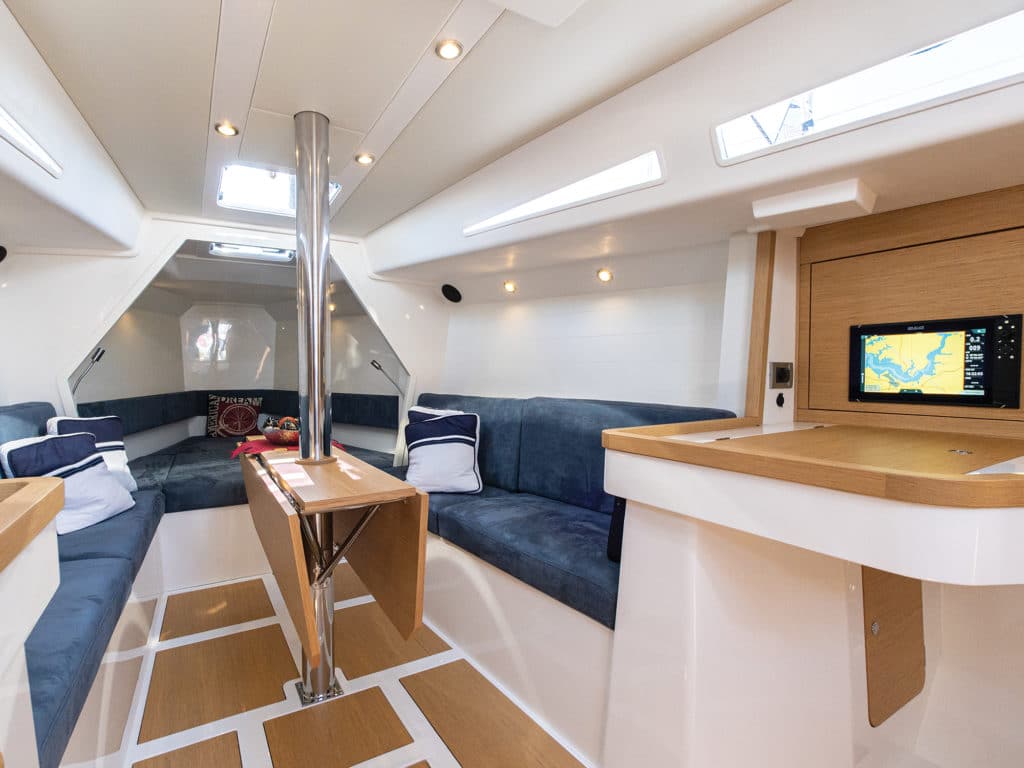
Whichever performance package you opt for, the accommodations remain mostly the same. But even then, you have choices. For instance, the open layout, in cruising mode, has a roomy double berth in the bow; but you can remove the cushions and their base when racing to convert the space into vast sail stowage. Likewise, much of the oak furniture and floorboards can be replaced with composite materials, or even carbon, for competitive sailors mindful of keeping weight at an absolute minimum.
Either way, a drop-leaf table in the center of the boat is flanked by a pair of settees, and there’s a spacious double cabin aft, to port, while the opposing starboard side includes a roomy head through which you can access a large storage area under the cockpit seat. For cruising applications, there’s storage galore.
We sailed the boat in light air, unfortunately, so we did not have the opportunity to put the boat through its paces properly. There’s no doubt, however, that she’ll haul the mail. mareblu.net; 619-840-3728
Italia 9.98
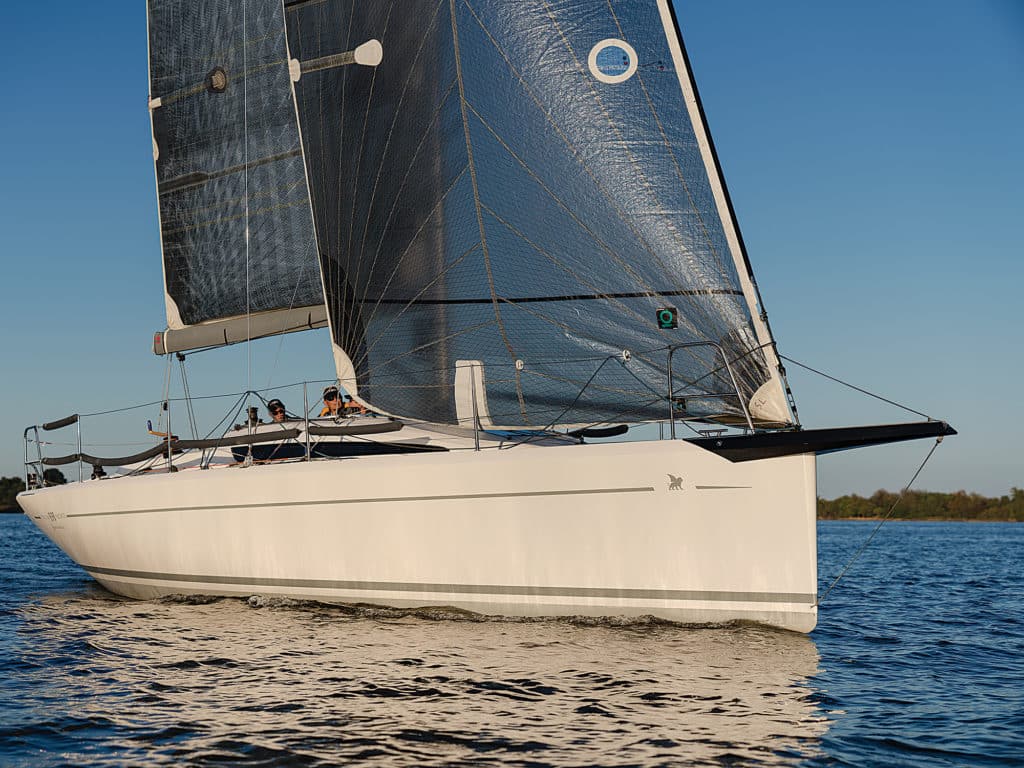
Of the five boats that comprised the Performance Cruiser class, in terms of sheer appearance, the futuristic 34-foot Italia 9.98 was easily the most distinctive. There are actually two versions of the boat: the 34 Club—which is the cruising alternative, the primary features of which are its twin wheels—and the 34 Fuoriserie—the racing model, and the one we tested, with its tiller steering being the identifying characteristic.
Both models share the same interior layout, and for cruising, the quarters are especially inviting and contemporary. The large double-berth forward is accessed by a large cutaway bulkhead trimmed in teak that doubles as a ring frame, and practically begs you to crawl in and kick way back. Two large, central settees flank the drop-leaf table that’s intersected by the keel-stepped spar.
Both the galley, to port, and the navigation station, to starboard, are most pleasant surprises: The former has a big fridge and gimballed, two-burner stove; the latter is much larger than one would expect on a boat of this size. Engaging details abound, including innovative, removable fabric lockers that can be offloaded when in racing mode, and cabin doors framed in aluminum for durability. Aft, there’s a generous double cabin to port, and a smaller double that also incorporates a big head to starboard. Other than sparing teak trim throughout, all furniture and fittings are clean, white composite structures that seem more aeronautical than nautical. Very modern and attractive.
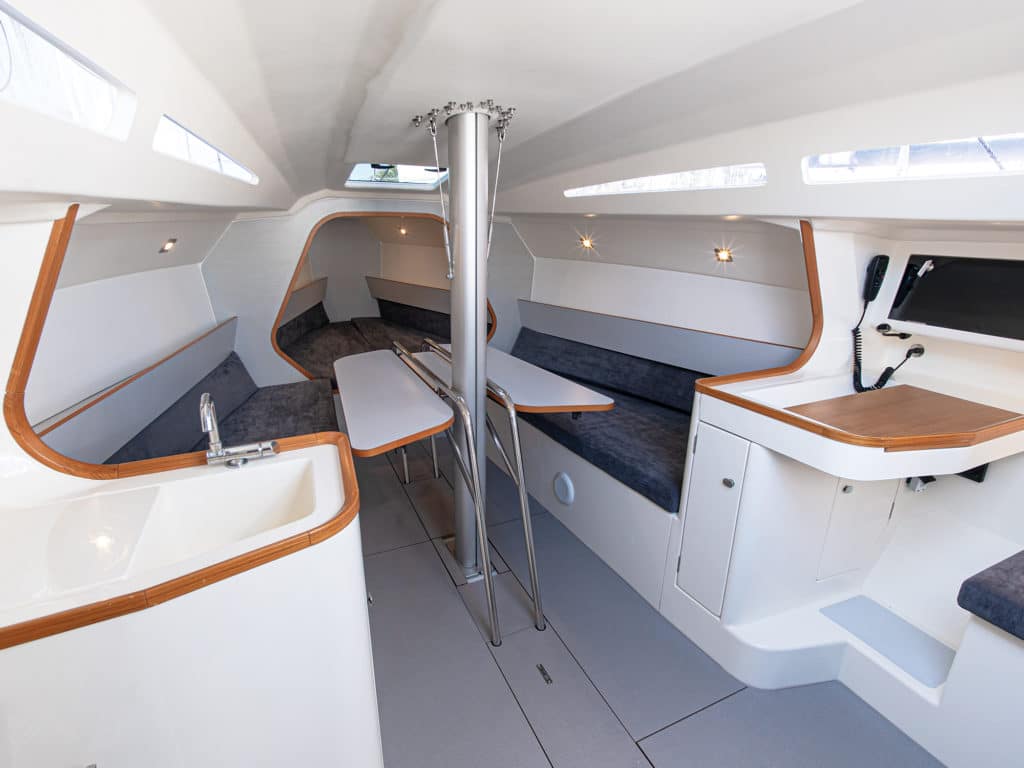
Topside, the cockpit is spacious; the short, molded-in bench seats can be lengthened with dedicated storage boxes, which you can leave on the dock when racing and reinstall when cruising. There’s a good-size lazarette locker aft of the beam-width traveler, which in turn is aft of the tiller. The open transom adds to the overall feeling of being on a larger vessel. The double-ended German-style mainsheet is led below deck, contributing to the minimalistic theme; the sheet leads, naturally, are adjustable. The truly outstanding nonskid is molded directly into the deck.
Our test boat was equipped with an optional sprit to fly reaching and off-wind sails. Another iteration of the sprit includes an anchor roller as well; the boat we sailed did not have a windlass, but there’s provision for one. It would be quite easy to convert this boat from racing mode to a solid cruiser. And you’d turn heads in every anchorage. italiayachtsusa.com; 410-279-3027
J/99
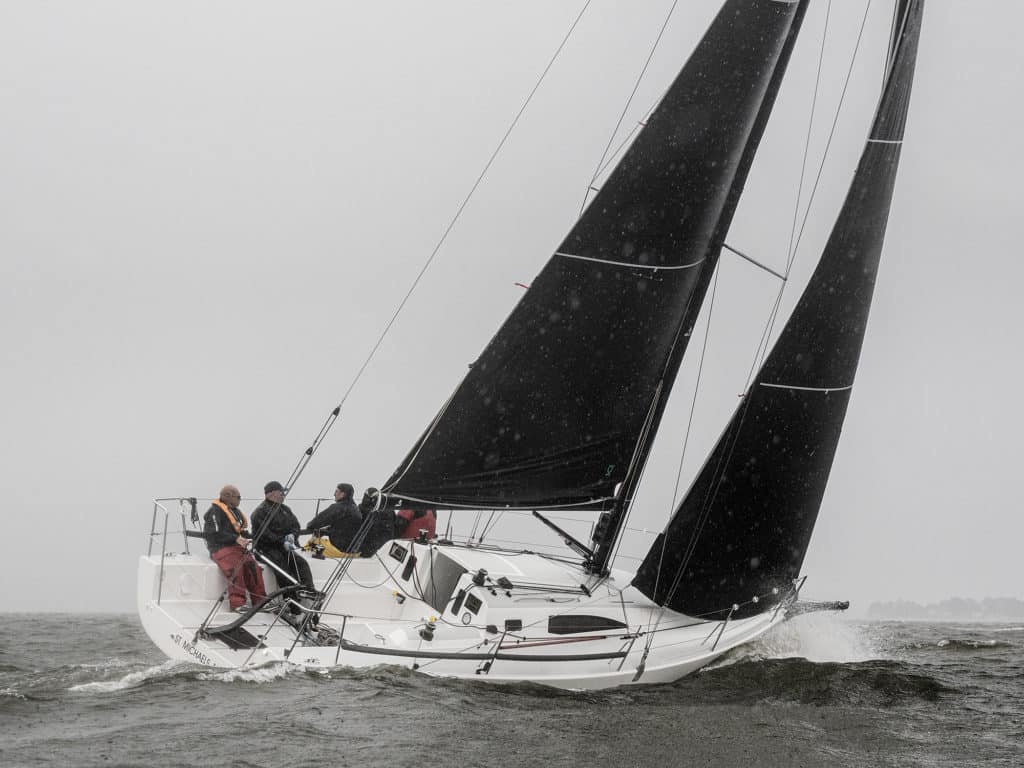
Beginning with the popular little J/24 way back in 1977, J/Boats has become famous for its steady introduction of terrific racing and cruising boats, almost all of which shared one main characteristic: They sailed like a witch. More than four decades later, having built more than 50 separate, mind-boggling models, the Johnstone family that designs, markets and sells the brand shows no signs of slowing down. Their latest offering, for 2020, was another fast and fun racer/cruiser: the 32-foot-7-inch J/99.
Our sea trials for Boat of the Year, conducted in a stiff 25-knot Chesapeake Bay breeze, was easily one of the most memorable test sails in this edition of the contest. The boat was fast, responsive and a joy to steer, perched on the weather rail with an extension for the tiller. Judge Ralph Naranjo was probably the most impressed of all. “It’s one of the most enjoyable small boats I’ve ever had a chance to sail,” he said.
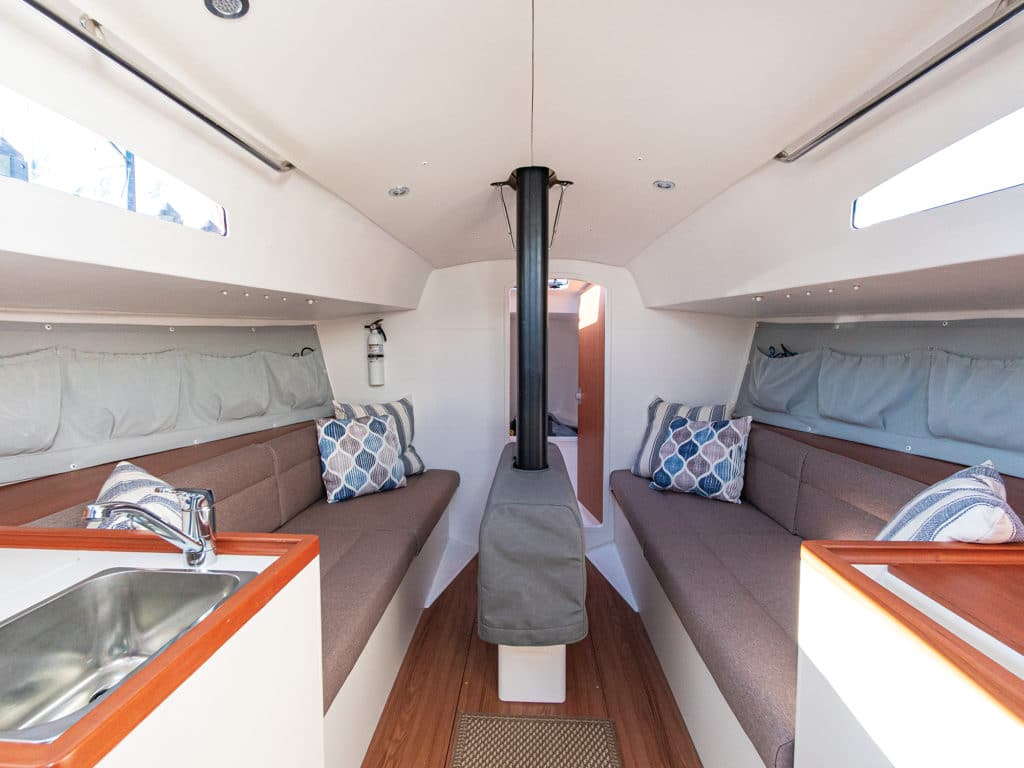
Everything about the deck layout is set up for efficient boat handling. The beam-width traveler is aft but readily at hand; optimizing mainsail trim in the lulls and puffs is clearly a priority, and coarse and fine-tuning options on the mainsheet further simplify this task. Halyards and reefing lines are led to a pair of Harken winches on the coachroof. A Harken furler handles the 100 percent jib. The sheet leads, naturally, are adjustable. In past designs, the company was well-known for its retractable bowsprits, but with the J/99, it opted for a fixed sprit that is more robust and can handle the loads imposed by today’s big asymmetric kites and code-zero reachers. The entire point of this exercise is easily attained—not to mention sustained—performance.
The “cruiser” part of the boat’s racer/cruiser calculation is the lesser of the two, but the boat is by no means stripped out. The head is forward, with the forepeak reserved for sail stowage. But there are good sleeping quarters in a pair of doubles aft, as well as the two settees in the main saloon that flank a central table. Nice teak trim lends warm and welcome accents to the nav station and galley, which was rudimentary on our test boat, but which can also be upgraded with a basic propane stove. Sure, this layout is more of a camper than a cruiser, but it’s also more than serviceable for a dauntless crew. When they gather around at the end of the day, it will be more than adequate for spinning yarns about the wonderful sailing they just experienced. jboats.com; 401-846-8410
Jeanneau Sun Fast 3300
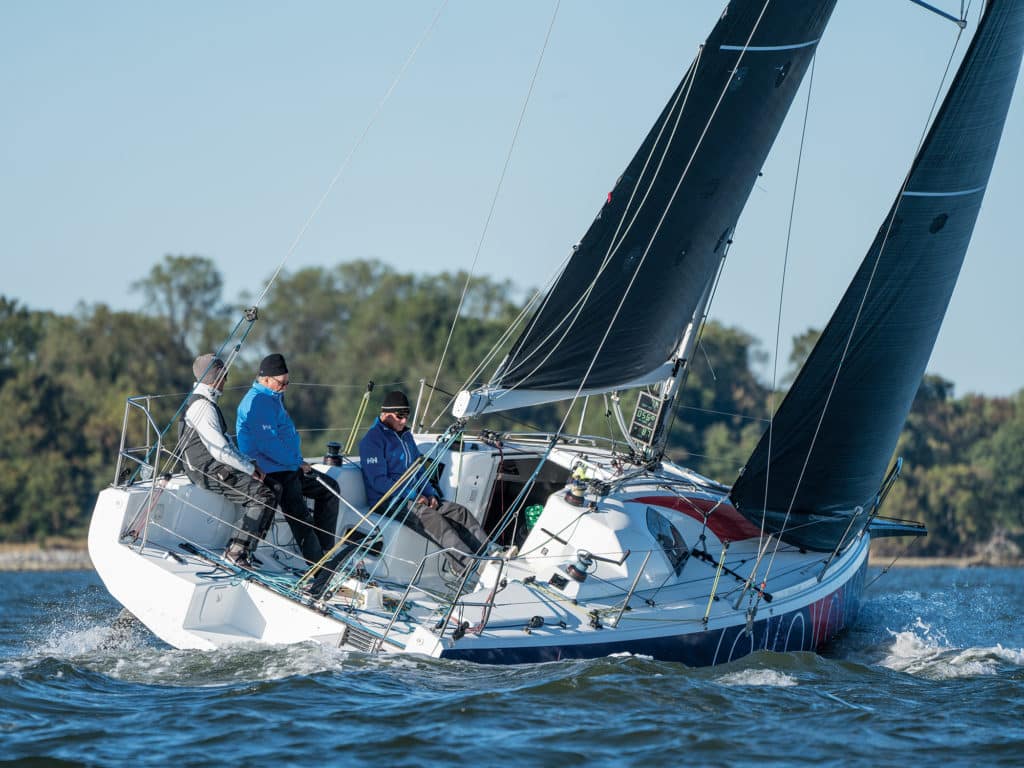
If there were any doubt about what the 32-foot-9-inch Jeanneau Sun Fast 3300 was designed and built for, it was put to rest by our sister publication, Sailing World—a racing magazine dedicated expressly to the need for speed—when it named the boat its overall Boat of the Year for 2020. So let’s get that right out of the way: The 3300, pure and simple, is a raceboat. Sure, the interior has the basics to allow its crew to navigate, prepare a hot meal and catch a few winks between watches, but the idea here is to get you there, and as quickly as possible.
The boat is actually optimized for doublehanded races, a growing segment of the competitive scene, especially in France, where the boat was designed and constructed. One of the naval architects on the project was Guilaume Verdier, whose design credits include the remarkable 100-footer, Comanche. There are hollows, or “concaves,” in the bow and stern of the boat to promote planing in certain conditions. Jeanneau clearly pulled out all the stops in creating the 3300.
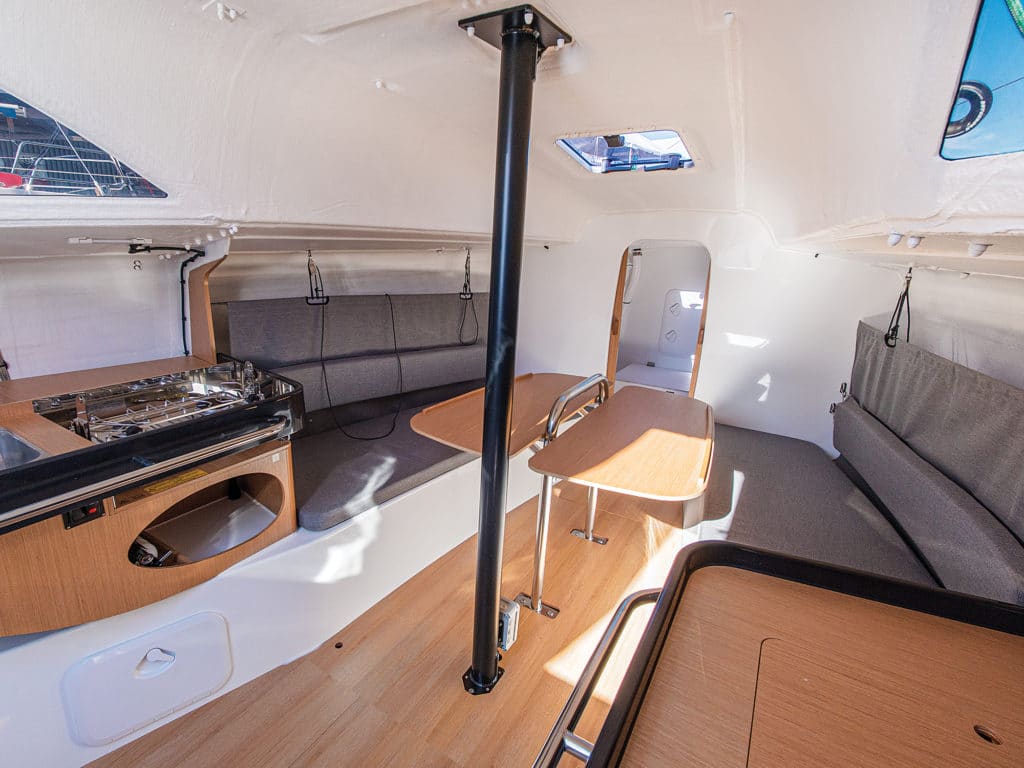
The deck-stepped rig—which will allow the boat to be shipped in a container for owners who wish to campaign the boat internationally—is carbon, of course. The list of tweakable features is endless. Both the mainsheet and running backstays are infinitely adjustable, with fine-tuned cascades for each. There are water-ballast tanks to simulate the weight of a full crew lining the windward rail when sailing in shorthanded mode. A three-dimensional jib–lead system provides the ability to dial in exact and precise headsail trimming. When racing, a five- or six-sail inventory will allow the crew to hoist and set the ideal sail combination for whatever the wind speed, sea state or point of sail.
Regarding the layout below, Sailing World editor Dave Reed wrote: “There’s not much glitz below deck, but that’s the point. The 3300 is no crossover cruiser. Inside the bowels of this white vinylester-infused capsule are nothing but rudimentary accommodations: galley, nav station, convertible settees and pipe berths that fold up to add additional crew berths. If distance racing and putting the boat away wet is what you desire, this is the level of interior you’ll come to appreciate.”
As the great designer Bill Lee once said, “A raceboat is like a jock strap you pull on to go racing.” So buckle up and hang on to your hats. And strap in, of course. jeanneau.com; 443-221-4203
Herb McCormick is CW’s executive editor.








